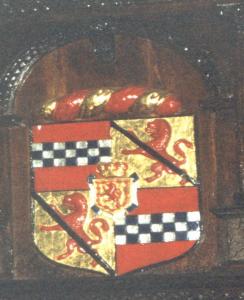
Sir David Lindsay of Edzell.
D 6.
Quarterly 1st and 4th Gules, a fess chequy Argent and Azure 2nd and 3rd Or a lion rampant debruised of a ribbon Sable; an inescutcheon for Nova Scotia (Argent a saltire Azure surmounted of an inescutcheon Or charged with a lion rampant within a double tressure flory counterflory Gules ensigned of an Imperial Crown Proper).
The Lindsay family were originally Anglo-Norman barons and held lands in both England and Scotland. Friends of King David I, they sat in Scottish Parliaments at the time the Kirk of Kilbirnie was first mentioned in history. The Arms of the Stewart Kings appear above (the fess chequy) with the difference in the colours; one of the family had been steward to the Steward of Scotland. The red lion of Scotland debruised to show that they could not claim the throne is the other component. This was the device of the Abbots of Abernethy.
The idea of a baronetcy in Nova Scotia was instituted by JamesVI. In 1624 a year before his death. The sum of 6,000 marks or the maintenance of 6 skilled settlers for two years, purchased 20,000 acres of land and the Badge on the Coat of Arms. A mark had a value of 13 shillings and fourpence Scots, which equated to one shilling and one and a halfpence sterling.
To enable the new barons to "take seizing" (cutting a piece of turf with a sword) a part of the esplanade of Edinburgh castle was declared to be Canadian territory.
Probably this did little for Nova Scotia, but more for the King’s pocket.
Page 7.